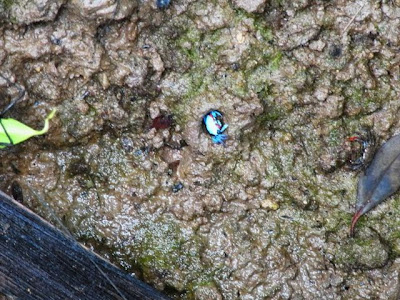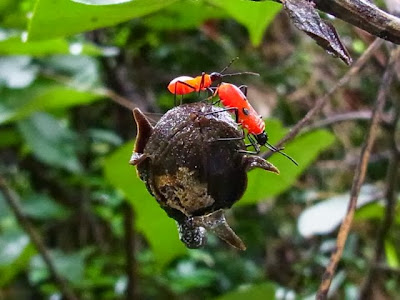We love Chek Jawa with all its natural splendor - forests, inter-tidal ecosystems, animals, birds, insects, fishes - so we are not going to let this outing pass without at least a post on our blog!
Here's the Big Group photo that we always take at the start of the walk. We didn't have that many visitors, somewhere around 30 visitors. But we had lots of guides that day. There's Pei Yan, Sankar, Ria, Yin Xin, Daniel, Kok Sheng and me (leykun). Kok Sheng had 5 of his students from Dunman High join us too. We all had a great time!
 |
| (what's Pei Yan looking at through her binoculars?) |
A quick introduction and briefing from the guides before we set off. We always ask our visitors to keep a lookout for animals and plants, and point them to us. It's an interactive exchange between guides and visitors. Sometimes, our visitors have lots of interesting stories to tell us too. We are constantly learning about nature from one another.
First destination is Jejawi Tower at the start of the mangrove boardwalk. Come prepared to climb this 6-storey lookout tower. And when you're up at the top, you'll get a special treat of viewing the environs around Chek Jawa. It is a wonderful view!
Now this is what you see from Jejawi Tower when you stand facing west. View of the Ubin forests; no buildings! Just trees ahead and birds in the air. A special treat indeed in our overly urbanised country! Pulau Ubin remains a wonderful destination for Singaporeans who want to get away from the hustle and bustle of city life. The way of life on Ubin, the forests, the fragile ecosystems are ours to treasure and protect.
From the tower, we get to see Pulau Tekong, and beyond that, a few hills in the state of Johor in the horizon.
 |
| flowers of the nipah |
 |
| nipah fruit cluster |
 |
| dispersal of the nipah fruits |
We got down from the tower and continued on the mangrove boardwalk. Some of our visitors were surprised to hear that this fruit gives us 'attap chee', an essential ingredient in ice chendol and ice kacang. The seed is harvested from each fruit in the cluster, then boiled in syrup to give us the chewy and yummy 'attap chee'.
Yes, this is the nipah palm (Nypa fruticans). The palm has a sugar-rich sap too, and from it, you can get toddy and palm sugar.
The nipah palm can be found along coastlines and river systems throughout South-east Asia, and many communities depend on the nipah palm as a cash crop.
 |
| Face-banded sesarmine crab |
And a lady from the group saw a shot of bright blue colour in the mud. There's this tiny blue crab. Can't miss its colorful claws and shell even though it's a tiny little fellow.
There were lots of bright red insects, less than 1 cm long, on the sea hibiscus tree. These must be the nymphs of the cotton-stainer bugs. The red colour is there, but the characteristic cross on the wings have not developed yet. These bugs feed on the fruits of the sea hibiscus tree.
This is the cannonball mangrove (Xylocarpus granatum), also known as the Puzzle Nut Tree. When the fruit ripens, it splits open and the seeds are dispersed. The seeds fit snugly in the cannnball shape. Once split, it is hard to assemble the odd-angled seeds back into the shape of a ball, hence its unusual common name, Monkey Puzzle. I've heard some of the guides call it "nature's own Rubik Cube". I think that describes it quite aptly.
A visitor drew the cannonball tree in her guestbook entry!
While another visitor wrote about the "Monkey Puzzle". Good to see this interesting plant has left an impression on our visitors.
A few of my visitors got a little unsettled when a solitary carpenter bee flew around us. It is oversized, black, shiny, and i admit looks rather mean. But it's a pretty harmless bee. The male carpenter is known to be stingless, while the female has a sting but is known to be docile unless provoked. These bees are usually seen flying around solitary. Don't forget bees are excellent pollinators, so do be kind to them! Put simply, we need them around!
Chek Jawa is quite scenic at low as well as high tide. Do come for a visit to enjoy nature, and some lovely views on the boardwalk.
View of the private jetty in front of the English Cottage.
We ended the walk with a short drawing session for the visitors. Some of them drew cute pictures of the animals that they saw, while others expressed their thoughts (some funny, some thoughtful) about Chek Jawa.
"Thanks for the very educational walk! Wow! This is how mangroves reproduce. Great discovery, a green snake!"
Do join us for our monthly free walks at Chek Jawa. You can find the signup page on our 2013 Chek Jawa schedule
Pei Yan and Ria wrote about this outing too. Here are their links:
Anniversary walk at Chek Jawa - by Pei Yan
6 years of Nakedness at Chek Jawa - by Ria
Viva Chek Jawa!


















No comments:
Post a Comment